Parts of a Shotgun: A Complete Guide to How It Works

Ever wondered how a shotgun works? Seasoned hunters, clay target enthusiasts, and casual shotgun buffs should each know the basic (and more technical parts) of a shotgun! In this guide, we break down the various components so you feel more confident while handling your shotgun.
Key Takeaways
- What Are the Parts of a Shotgun? The key parts of a shotgun include the stock and forend for aiming, the trigger, trigger guard, and safety, for shooting safely, and the receiver, barrel, bore, muzzle, and choke for loading the ammunition and controlling the bullet’s direction and spread.
- Parts of a Semi-Automatic Shotgun: Semi-automatic shotguns deliver rapid-fire, featuring distinctive components like the bolt handle and carrier release.
- Parts of a Break-Action Shotgun: Break-action shotguns hinge open to reveal the breach, and they incorporate components like an opening lever, barrel selector, lugs, and more.
- Exploring the Components of a Pump Action Shotgun: Pump-action shotguns are classic firearms equipped with various components, including a magazine tube and ejection port.
What Are the Parts of a Shotgun?
Shotguns feature core parts from the muzzle to the stock. Different types of shotguns, like semi-automatic and break-action, come with distinct parts specific to their operation.
-
The stock and forend help you aim and fire steadily.
-
The trigger, trigger guard, and safety ensure you can shoot safely and accurately.
-
The receiver houses the action while the chamber loads ammunition.
-
The barrel, bore, muzzle, and choke control the trajectory and accuracy of the bullets.
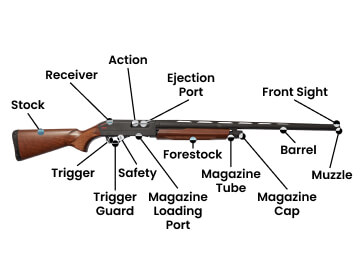
Expert Tip:
Shotguns can use different types of shot shells or slugs — making them versatile for hunting, clay shooting, or even home defense.
If it’s your first time owning a shotgun, you’ll want to know how to identify each part. Shotguns have some components in common. We’ll break down the different parts of a shotgun into the following sections:
The 4 Main Parts of a Shotgun
Knowing your shotgun inside out, from the stock to the muzzle, is essential. Below, we'll delve into the four main parts of a shotgun.
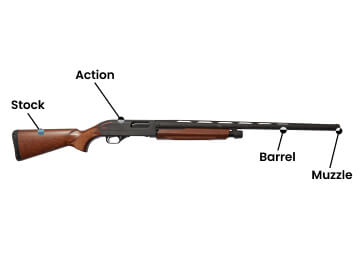
-
Stock: The stock is the part of the shotgun that you grip and shoulder when aiming and firing. Different shotgun models may feature various stock designs to suit specific shooting preferences.
-
Action: The action is the core mechanism of the shotgun responsible for loading, firing, and ejecting shells. It determines the type of shotgun, such as pump-action, semi-automatic, or break-action.
-
Barrel: The barrel is the elongated tube at the front of the shotgun through which shot pellets or slugs pass through. It defines the shotgun's effective range, pattern spread, and accuracy.
-
Muzzle: The muzzle is the end of the barrel from which all projectiles exit when fired. Different types of muzzles and choke systems allow shooters to customize their shotgun's performance for specific applications.
Learn About the Action & Trigger Mechanism
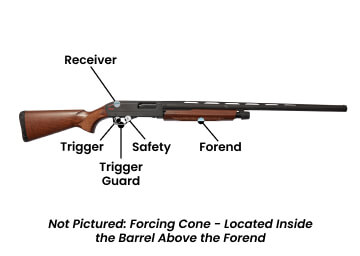
You should know where to grip the gun and where to locate the safety. The key action and trigger parts of a shotgun include:
-
Safety: Shotguns feature various safety designs, like a cross bolt or button. The safety prevents you from firing until you're ready.
-
Trigger: The trigger is the part you squeeze to ignite and fire a bullet. In some shotguns, you may find a double trigger.
-
Trigger Guard: The trigger guard acts as a protective shield, preventing accidental trigger engagement. It typically has a loop-like design surrounding the trigger area.
-
Receiver: Often referred to as the frame, the receiver is where you can find the action of the shotgun. It plays a central role in the shotgun's operation.
-
Forcing Cone: You can find the forcing cone in front of the chamber. It helps guide your shot into the bore. A tighter cone yields a tighter shot pellet group that gradually expands down range.
-
Forend: The forend (also known as forearm, handguard or forestock) is where you grip the shotgun in front and place your fingers when aiming and firing. It may be more slim or thick, depending on the gun.
Sights and Magazine

Effective shotgun use relies on proper sights and magazines. Explore the key components of sights and magazines below:
-
Rib: The rib is a ventilated strip on the top of the barrel that helps you accurately align the shotgun with the target. It serves as a visual guide for aiming.
-
Bead: Located at the muzzle's tip, the bead acts as a sight. While you don't focus on it, the bead sight is a reference point for muzzle direction — ensuring safe aiming.
-
Magazine Cap or Latch: This component secures the forend to the shotgun and holds the barrel in the action. You can find the forend latch on break-action shotguns.
-
Choke: Shotguns offer various choke options, each affecting the bullet pattern's constriction. You can select different chokes to achieve the desired bullet spread, making them a critical part of shotgun performance.
Grip and Recoil Management
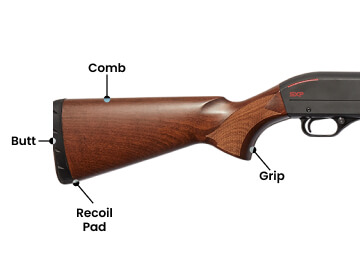
When you fire a shotgun for the first time, you might be surprised by the recoil it generates. Explore the shotgun components that impact grip and recoil below:
-
Grip: Shotguns offer different grip styles, including options like Prince of Wales or no grip at all. This is where you hold the firearm.
-
Comb: The comb is the part that comes into contact with your cheek when you fire the shotgun. Some shotguns may have a raised comb, depending on their design.
-
Butt: The butt of the shotgun is the portion that rests against your shoulder. When you fire the shotgun, the butt helps to distribute the recoil force.
-
Recoil Pad: You can use a recoil pad to reduce the shotgun's recoil by dispersing energy upon firing. You can buy recoil pads to reduce the felt recoil.
Parts of a Semi-Automatic Shotgun
Semi-automatic shotguns boast two distinctive functions: gas operation and inertia operation. Their streamlined operation and rapid follow-up shots set them apart from other shotguns. Once primed and ready, shooters can unleash a rapid succession of rounds with each trigger pull. These shotguns feature specialized components that enhance their performance.
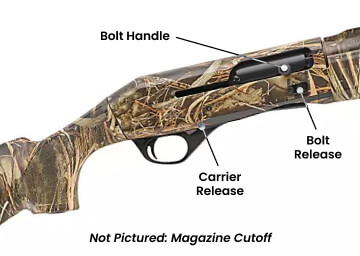
-
Bolt Handle: The charging handle is another name for it. When you engage the bolt handle with the bolt, it acts as a lever that allows manual opening of the action.
-
Bolt Release: On most guns, the bolt release is a button that closes the bolt. You can find the bolt release beneath the ejection port. Larger and more user-friendly bolt releases are the hallmark of modern design.
-
Carrier Release: You can locate the carrier release on the carrier or trigger guard of many semiautomatic shotguns. The carrier releases a fresh shell from the magazine. You need to press it to keep the handgun unlocked and in the open position.
-
Magazine Cutoff: A lever or button on some shotguns lets you switch out the ammunition. Changing the type of shell in the chamber quickly is made possible by this functionality. You can use this to hunt a variety of game, including birds.
Parts of a Break Action Shotgun
Break action shotguns come in single and double-barrel configurations, including over-under and side-by-side models. These shotguns feature a distinctive lever to open or "break" the firearm along its hinge.
Inside, break-action shotguns house unique parts that enable them to function effectively. The simplicity of their design makes break-action shotguns a popular choice for hunting and other applications.
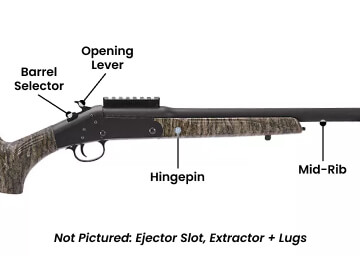
-
Opening Lever: Break action shotguns feature a top-mounted lever on the frame. You can find this on the side or bottom. This lever opens the shotgun, providing access to the chamber for loading and unloading.
-
Ejectors/Extractors: Break action shotguns are equipped with either an ejector or extractor mechanism, allowing for the efficient removal of spent shell casings. This quick ejection or extraction process facilitates the swift loading of a new shell.
-
Barrel Selector: The barrel selector is a feature that enables users to choose which barrel fires first. Typically, it is located near the shotgun's safety mechanism, providing shooters with control over the firing sequence.
-
Hinge Pin or Trunnions: Break action shotguns pivot around a sturdy steel hinge pin, usually located on the bottom of the frame. This hinge pin serves as the axis for the shotgun's opening and closing action.
-
Lugs: These are steel projections on the bottom of the barrel that securely fit into matching recesses on the receiver's floor. This system of lugs and recesses adds strength to the shotgun's structure when it's fired.
-
Mid-Rib: You can locate the mid-rib atop the shotgun's barrel. Its purpose is to reduce glare caused by the sun's reflection. In double-barrel shotguns, the rib between the barrels is called the mid-rib.
Exploring the Components of a Pump Action Shotgun
The pump action shotgun is a classic firearm known for its distinctive "ch ch" sound. It operates manually using a sliding fore-end; when pulled towards you, it ejects a spent shell and chambers a new one. Key components unique to pump-action shotguns include:
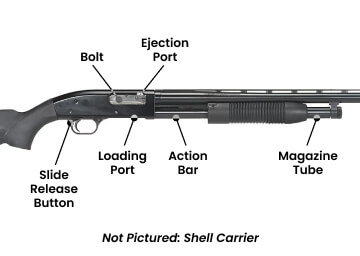
 Gift Cards
Gift Cards Big Fun Deals
Big Fun Deals Hot Deals
Hot Deals Clearance
Clearance

